There are three ISO certificates for quality certification. The certificates will be shown later. ISO
After receiving the advance payment, the production cycle is 15-25 days. And the transportation cycle should be calcul……
We supply with installation guide and user manual for each transformer. If you do not understand them. We will offer v……
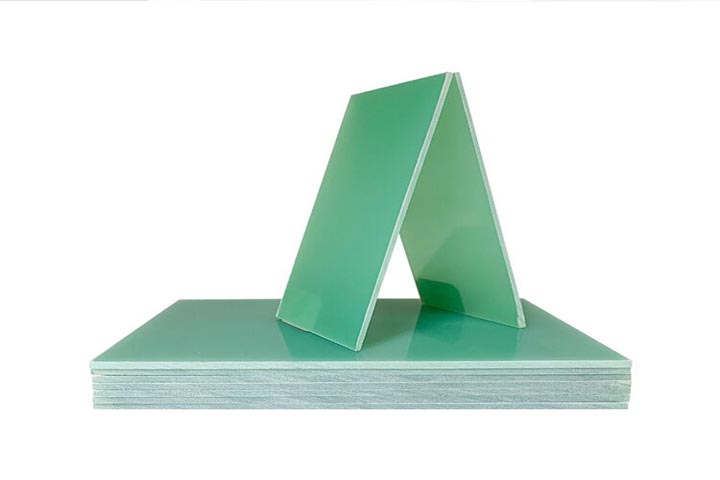
Material: Fiberglass
Size: 1020*1220mm/1020*2040mm
1220*2040mm/1220*2440mm
Standard Thickness: 0.5-50mm
Color: Aqua Green
Surface: Polished surface, Matte surface
Sample: Available
Customization Service: Available
Email:[email protected] Whatsapp:+8613137718313
FR-4 epoxy fiberglass sheet is also called epoxy fiberglass cloth laminated board. It is plate-like laminated products formed by electronic grade fiberglass cloth impregnated with epoxy resin and fire retardant under hot pressing of high temperature and pressure with high mechanical property and dielectric property, FR4 is a NEMA grade designation for glass-reinforced epoxy laminate material. It’s composed of woven fiberglass cloth with an epoxy resin binder that is flame resistant (self-extinguishing)Epoxy Laminate.
The “FR” in FR4 stands for “flame retardant,”4 Represents glass epoxy resin. particularly in the manufacturing of printed circuit boards (PCBs).good heat and moisture resistance, as well as strong mechanical processing property.
The insulation class is F class, and the main color is white(original color), aqua, black and yellow.
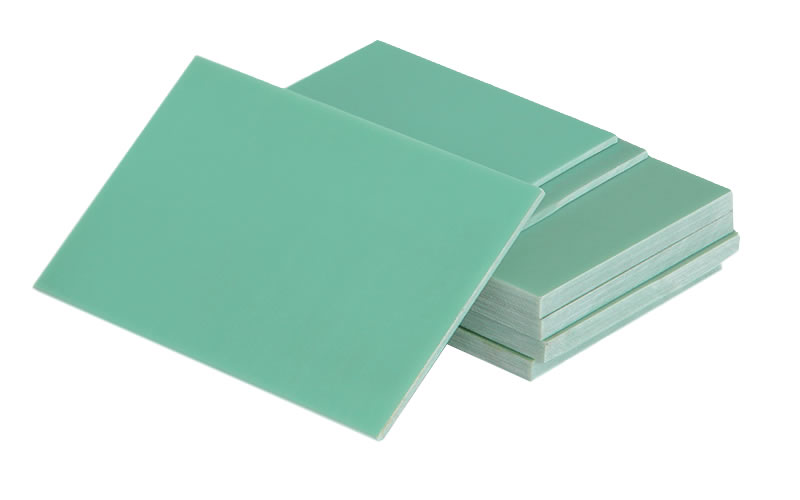
Material: Fiberglass
Size: 1020-1220mm/1020-2040mm
1220-2040mm/1220-2440mm
Standard Thickness: 0.5-50mm
Surface: Polished surface, Matte surface
Specific gravity/density: 1.850 g/cm³
Water absorption: Less than 0.10%
Temperature index: 140°C
Thermal conductivity: Through-plane 0.29 W/(m·K), In-plane 0.81 W/(m·K)
Flexural strength: LW > 415 MPa, CW > 345 MPa
Dielectric breakdown: > 50 kV
Relative permittivity: 4.4
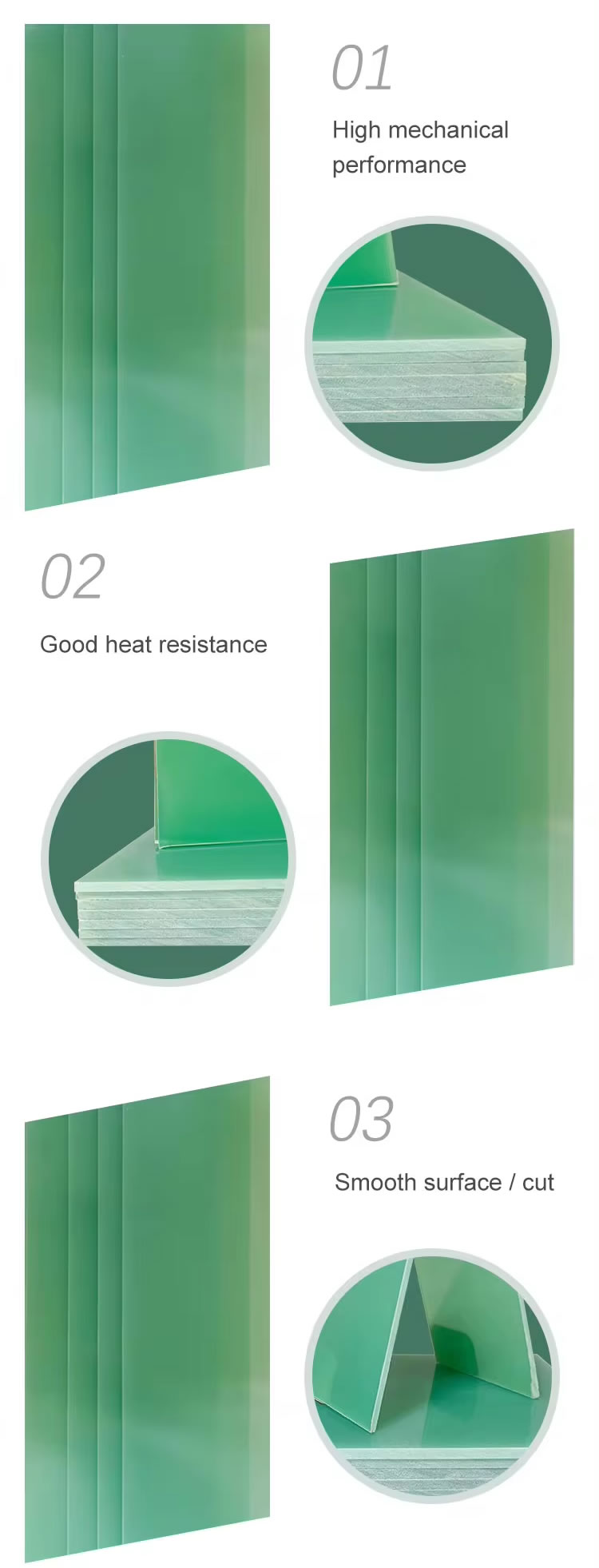
High mechanical strength: Fiberglass reinforcement gives FR-4 substrate excellent bending and impact resistance, and can withstand the stress caused by complex circuit layout.
Excellent electrical performance: FR-4 fiberglass sheet has good electrical insulation performance, which can effectively prevent interference and short circuits between different circuits on the circuit board, ensuring the stability and reliability of signal transmission.
Good flame retardant performance: UL94 V-0 level flame retardant performance enables FR-4 fiberglass sheet to quickly self-extinguish when encountering fire, greatly improving the safety of electronic and electrical products.
Good processing performance: FR-4 fiberglass sheet is easy to drill, cut, bend and other processing operations, suitable for realizing complex multilayer board structures.
Moderate cost: Compared with other high-performance materials, the manufacturing cost of FR-4 fiberglass sheet is relatively low, suitable for large-scale production.
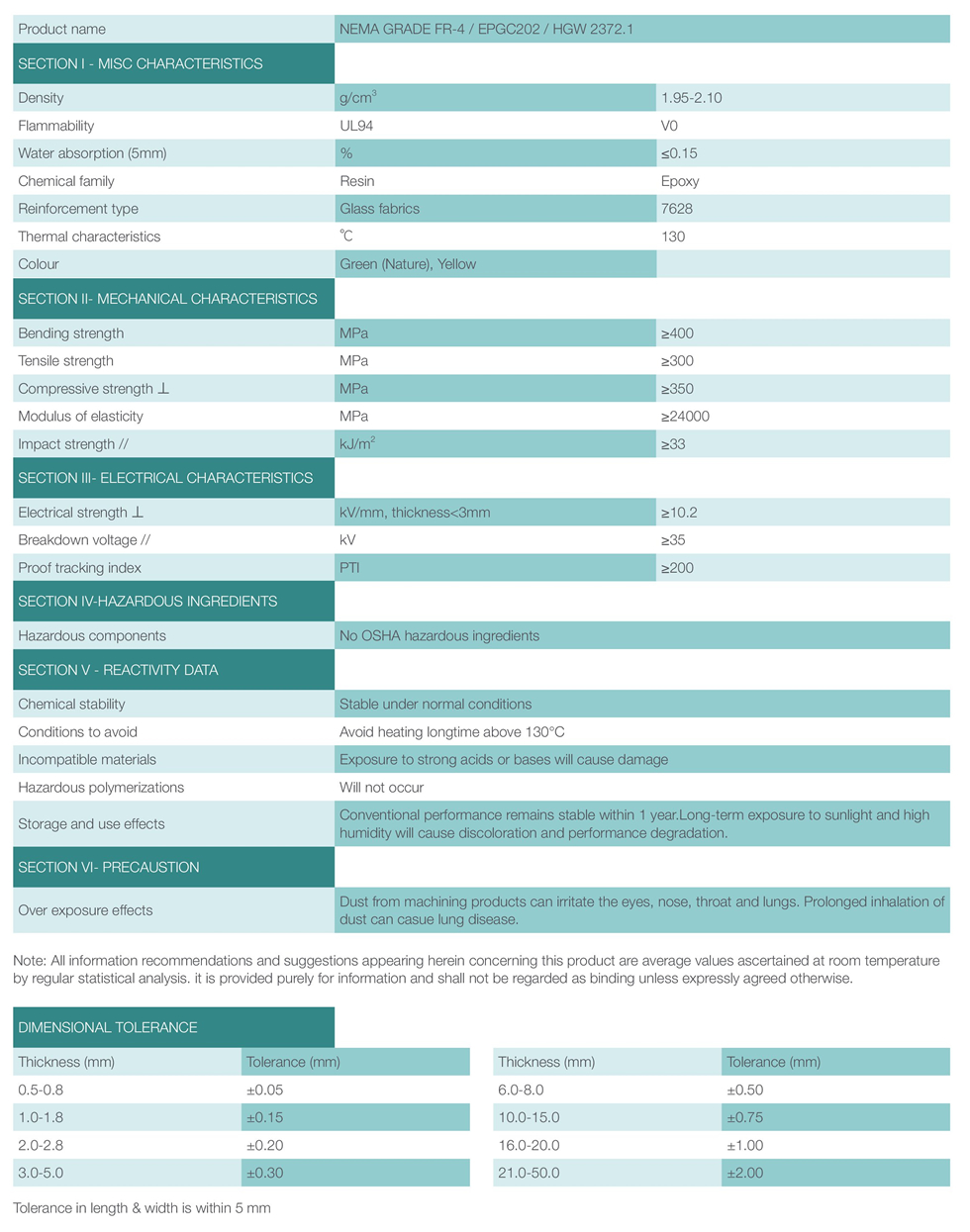
FR-4 epoxy sheets are versatile materials used across various industries due to their excellent electrical, mechanical, and thermal properties. Here are some specific applications:
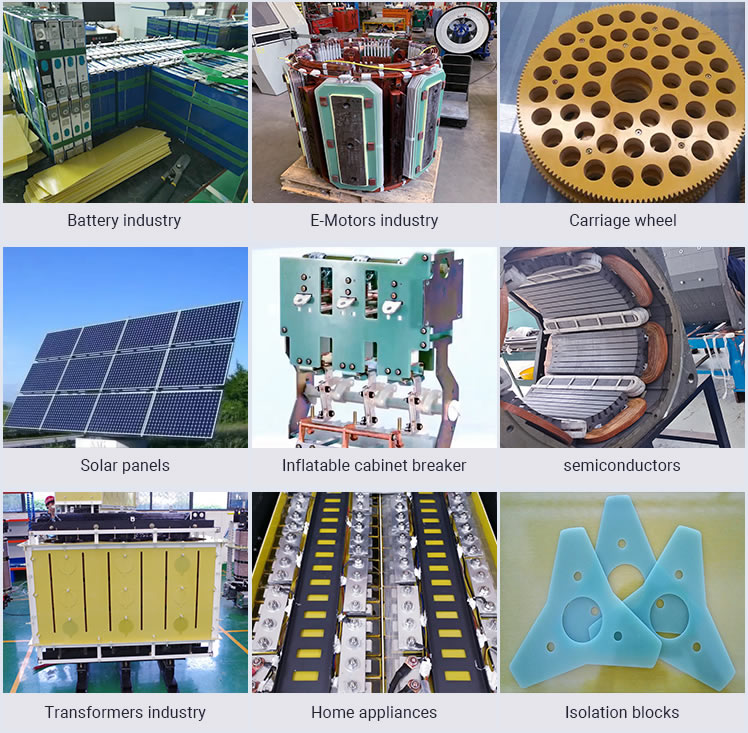
1. Printed Circuit Boards (PCBs)
Application: The primary use of FR-4 epoxy sheets is as a substrate for PCBs, providing the base for electronic components.
Benefits: Offers good insulation, durability, and the ability to withstand high temperatures during soldering processes.
2. Electrical Insulation
Application: Used in various electrical devices as insulating material, such as transformers and switchgear.
Benefits: High dielectric strength and non-conductive properties ensure effective insulation.
3. Mechanical Components
Application: FR-4 sheets are used to fabricate structural components like brackets, panels, and housings in machinery and equipment.
Benefits: Provides mechanical strength, stability, and resistance to wear and tear.
4. Aerospace Components
Application: Utilized in avionics, radar systems, and other aerospace technologies.
Benefits: Flame retardant and lightweight, making it suitable for high-performance applications.
5. Automotive Parts
Application: Commonly found in automotive electronics, such as engine control units and infotainment systems.
Benefits: High thermal resistance and moisture durability make it ideal for automotive environments.
6. Telecommunications Equipment
Application: Used in routers, base stations, and other telecom devices.
Benefits: Ensures reliable performance in demanding communication systems.
7. Consumer Electronics
Application: Found in smartphones, tablets, and computers.
Benefits: Lightweight, cost-effective, and provides reliable insulation for complex circuitry.
8. Industrial Equipment
Application: Employed in control panels, PLCs, and various sensors.
Benefits: Durable and reliable, essential for industrial automation systems.
9. Medical Devices
Application: Used in diagnostic and monitoring devices, including imaging equipment.
Benefits: Non-toxic and stable under varying conditions, crucial for medical applications.
10. Custom Fabrications
Application: Custom parts and prototypes for specialized applications across different industries.
Benefits: Versatile and can be machined to precise specifications.
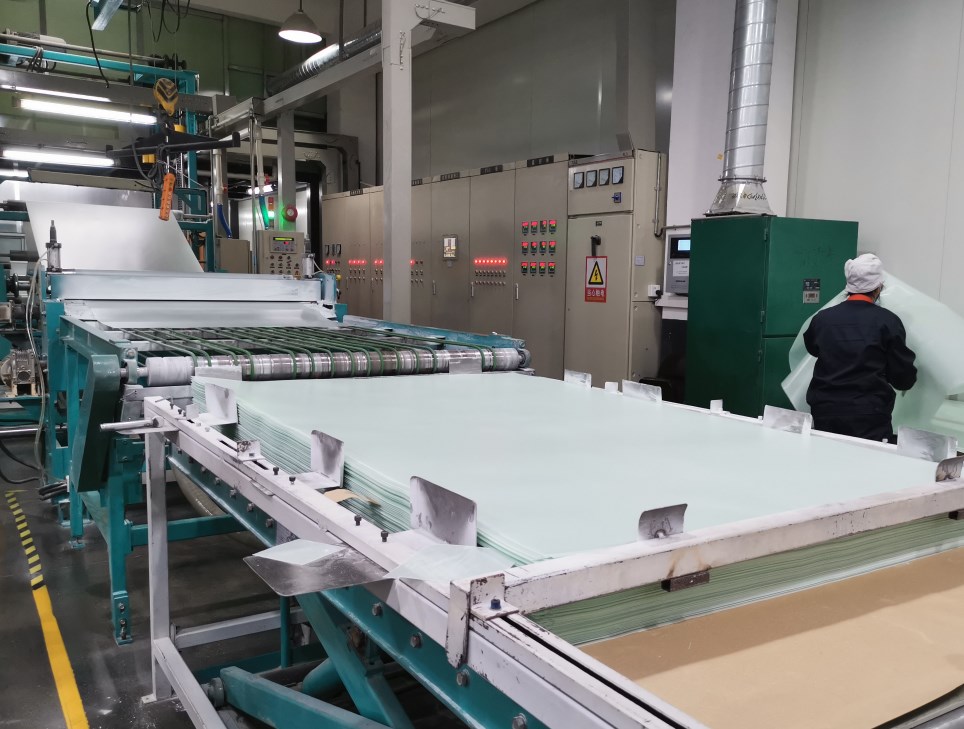
The manufacturing process of FR-4 involves several carefully controlled steps to ensure the material meets stringent quality standards.
Here’s an overview of how FR-4 is made:
1.Selection of Raw Materials: High-quality glass fiber cloth and epoxy resin are selected as the core components.
2.Impregnation: The glass fiber cloth is impregnated with epoxy resin, sometimes along with certain fillers to improve properties like flame retardancy.
3.Laying Up: The impregnated glass cloth layers are arranged meticulously to form a stack.
4.Pressing: The stack is then placed in a press, where it is subjected to heat and pressure. This bonds the layers into a single, cohesive sheet.
5.Curing: The pressed sheets are cured to solidify the resin, which also enhances the material’s mechanical and thermal properties.
6.Cutting and Finishing: The cured sheets are then cut to size and finished according to customer specifications. This may involve CNC milling, water-jet cutting, or other machining processes.
The result is a sturdy, versatile material that exhibits excellent mechanical strength, electrical insulation, and resistance to high temperatures, making it ideal for a variety of applications, particularly in the electronics industry for PCBs. The FR-4 material can also come in different forms, such as pre-impregnated cloth (prepreg), pressed sheet, wound tube, or as finished parts.
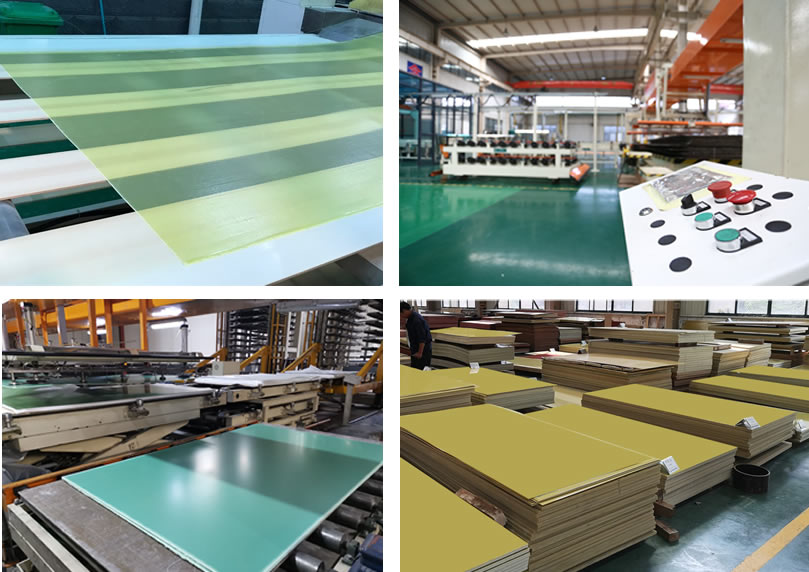
Epoxy sheets such as FR-4, FR-5, and G10 are all made from glass cloth impregnated with epoxy resin, but they have different properties and uses due to variations in their composition and manufacturing processes. These are all electrical insulating materials, here is their comparison:
FR-4: This is the most commonly used material for printed circuit boards (PCBs). It is flame retardant due to the addition of bromine to the epoxy resin, which helps to extinguish flames. FR-4 has good mechanical and electrical insulation properties and is suitable for a wide range of temperatures.
FR-5: Similar to FR-4, FR-5 also has flame retardant properties. The key difference is that FR-5 has a higher temperature rating than FR-4, making it suitable for applications that require better thermal stability and mechanical strength at elevated temperatures.
G10: Unlike FR-4 and FR-5, G10 does not contain brominated epoxy resin, which means it is not flame retardant. However, it has excellent mechanical properties, high dimensional stability, and is resistant to water, making it suitable for applications where flame retardancy is not required. G10 is often used in electrical insulators and structural components.
In terms of mechanical strength, G10 exhibits a higher flexural strength compared to FR-4, making it more resistant to bending forces. However, FR-4 and FR-5 materials may offer superior mechanical and electrical properties due to modern resins and manufacturing processes.
Design engineers should consider the specific requirements of their applications, such as flame retardancy, mechanical strength, electrical insulation, and environmental resistance, when choosing between these materials. Each material has its advantages and is best suited for different types of applications within the electronics and mechanical design industries.
Choosing the right FR-4 sheet involves considering several factors based on your specific application requirements. Here are some key aspects to evaluate:
1. Thickness
Standard Thicknesses: FR-4 sheets come in various thicknesses (commonly ranging from 0.5 mm to several millimeters). Choose a thickness that meets your mechanical strength and insulation needs.
2. Grade and Type
NEMA Standards: Ensure the FR-4 sheet meets relevant NEMA (National Electrical Manufacturers Association) standards. Common grades include FR-4, which is general-purpose, and specialized grades for high-frequency or high-temperature applications.
3. Glass Fabric Type
Woven vs. Non-woven: Woven fiberglass offers greater strength and rigidity, while non-woven options may provide different mechanical properties. Choose based on your structural requirements.
4. Dielectric Strength
Electrical Insulation: Check the dielectric strength rating, which indicates how well the material can insulate against electrical currents. Higher ratings are preferable for high-voltage applications.
5. Flame Retardancy
Fire Safety: Ensure the FR-4 sheet has appropriate flame-retardant properties suitable for your application. Look for certifications like UL 94 V-0 for enhanced safety.
6. Moisture Absorption
Environmental Resistance: Consider the moisture absorption characteristics, especially for applications in humid or wet environments. Lower absorption rates will help maintain performance.
7. Thermal Properties
Heat Resistance: Evaluate the thermal conductivity and thermal stability, particularly for applications where the material will be exposed to high temperatures.
8. Machinability
Ease of Fabrication: Consider how easily the FR-4 sheet can be cut, drilled, and shaped for your specific design needs.
9. Cost
Budget Considerations: Compare prices based on the required properties and applications. Higher-performance materials may cost more but offer better reliability.
10. Supplier Quality
Reputation and Standards: Choose reputable suppliers who provide quality assurance and documentation, ensuring the material meets industry standards.
Ztelec Group is a professional manufacturer of high-quality electrical insulation materials with more than 60 years of manufacturing experience.
If you need more product information and quotes, please contact us
Samples(100*200mm or 200*300mm) can be sent free of charge.
customers just need to bear a little shipping charge
If you need our products please write down any questions, we will reply as soon as possible.